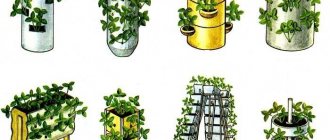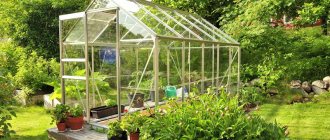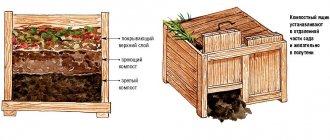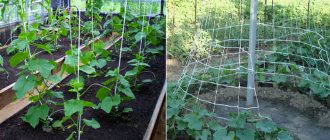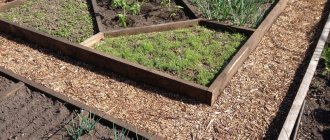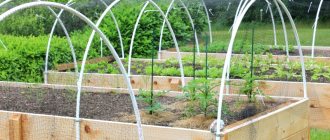When is it better to make warm beds: in spring or autumn?
Many will be surprised, but it is possible to get an early harvest of cucumbers without a greenhouse. For this purpose, warm beds are used. They work using thermal energy, which is generated as a result of complex physical and biochemical processes. This is a natural heating pad that helps plants develop faster and survive temperature changes. They are made from grass and organic fertilizers. Plus, decaying organic matter forms nutrients. We discussed the general rules for creating warm beds in this article.
Fertilizers begin to rot, release heat, and a reaction occurs - exothermic, in which aerobic and anaerobic bacteria participate. In the early stages, the temperature does not rise much, but every day it grows higher and higher.
You can prepare structures both in spring and autumn. To form beds in the fall, you have more plant material to fill the bed, which will be much fresher than in the spring. This includes any garden waste: leaves, branches, sawdust, twigs, stems, fruits, etc. In addition, in the fall there is more time for harvesting material and the temperature is suitable and the humidity is high. You can start cooking after harvesting; there is no need to rush anywhere. By spring, the soil will be sufficiently fertilized, all plant components will have time to rot and turn into compost. A good warm bed can last from 3-4 years to 7-8 years.
When to make a garden bed
Gardeners consider autumn to be the optimal time for organizing borage. At this time, the harvest is harvested and there is time to thoroughly prepare for the next season. In addition, after cleaning the garden and surrounding area, plant waste remains. They will have time to rot before landing. By spring, the soil will be well fertilized and ready for planting cucumbers.
For your information!
To mulch a warm cucumber bed in a greenhouse, you can use straw or fresh grass.
If the opportunity to organize an embankment in the fall is missed, it can be done in the spring. The main condition is that the heating layer must be laid at least one month before planting. In addition, due to limited time, substances that quickly rot are used. Even if the soil does not have time to fill with nutrients, it can still warm up for use.
Pros and cons of warm beds in open ground
Cucumbers are grown in different conditions: a greenhouse, on a vertical trellis, in barrels, boxes and open ground. But the main problem of every gardener is providing sufficient heat. Cucumbers require at least 15 degrees, but a stable average daily temperature occurs in the middle zone in June.
Therefore, for an early and high-quality harvest, it is worth taking auxiliary measures. The ideal solution is warm beds. Their advantages over other types are as follows:
- Little labor intensity. It’s easy to form, even a beginner can handle it. Plus it lasts for several years.
- Disposal of garden waste such as plant debris, branches, leaves, fruits. Everything is suitable for creating warm beds.
- They can be planted in the spring, when the heat from organic components warms the ground.
- There is no need to apply additional inorganic or mineral fertilizers. Organic matter, which decomposes inside the bed, provides the plants with all the necessary substances.
- The ripening of the crop occurs much faster, and there are also fewer problems with its quality.
- The arrangement of the bed provides natural drainage to the plants.
Among the disadvantages are usually difficulties with formation and maintenance after winter. It is also important to select the correct proportions of biomaterial so as not to ruin the plantings.
Growing Shosha cucumbers.
To learn more
Proper preparation of the necessary soil
It is recommended to prepare the soil in the fall. Building a bed is easier to do after the harvest, since the gardening work on the site has been completed. Compost is prepared mainly in the fall, since during the winter it will have time to “rest” and go through a full stage of rotting. In the spring season, boiling water is poured over rotted compost, covering the top with film. Manure begins to generate heat over a period of time. After 2 weeks, seedlings are planted.
In the spring, arranging beds is a labor-intensive process. You must wait until the ground thaws. Then they begin to create a warm box. The peculiarity of this method is that it is necessary to prepare the soil in advance for planting vegetables. Fill the trench with plant waste or compost and spill with hot water. Check the soil for warming up. Then the plants are prepared for planting in the ground.
Setting up a warm bed for cucumbers
What to fill with
Almost any organic matter is suitable for filling: branches and trunks of felled trees, fruits, leaves, sawdust, weeds. Conventionally, the material is divided into fresh green and brown.
When forming, it is important to know that when green organic matter rots, nitrogen is released. It speeds up processes, but ammonia is released along with it. But this is a serious disadvantage, because it kills the bacteria involved in the process. As a result, the entire process will stop and heat will no longer be released.
The brown part promotes the release of carbon as well as hydrogen. Together, both gases turn into methane. This swamp gas is explosive, so be careful around these structures.
In order for the structure to help harvest the crop without causing inconvenience, it is important to maintain a 1:3 proportion of green and brown material. To create, take no more than 20-25% of fresh leaves and grass, the rest should be branches, sawdust, brushwood. Thanks to them, the reaction will be long-lasting and beneficial for vegetables.
Making a warm bed with your own hands is not difficult, the main thing is to follow the technology. Essentially this is a compost pit. The key to a correct reaction, the absence of mold, the development of disease, the bed must be constantly moistened and not disturb the supply of oxygen.
How to fill a warm bed
Create structures in the following stages:
- The base consists of large, long-decomposing material. Stumps, trunks, stalks from corn, Jerusalem artichoke, sunflower, and large branches are suitable. Plus you get excellent drainage for air exchange. The layer should be loose and at its highest more than 0.4 m.
- Before laying the next layer, thoroughly water the previous one.
- Next, lay newspaper, paper or cardboard. It is advisable to crumble and tear everything.
- Next layer: branches of bushes or trees.
- Then they lay down foliage, plucked grass, and tops.
- The final layers are compost or rotted manure, a layer of earth or garden soil.
But these are general recommendations; depending on the type and size of the structure, some layers can be removed. Each layer should be lighter than the previous one and from 5 to 15 cm thick. Instead of leaves, flowers, tops, and peelings are suitable. You can also line each layer with straw or thin branches so that everything does not turn into lettuce due to melting snow.
Instead of compost, rotted manure and humus are suitable.
Use only plant waste from healthy plants, free from fungi and pests. Also, you should not bury plants with seeds, otherwise they will germinate along with the cucumbers.
Another important point is protection from rodents. Line the bottom with a metal mesh.
The essence of the method
Warm beds for cucumbers are made from manure or several types of organic matter (branches, tops, grass, droppings), laying them in layers in the so-called “pie”. It is important to “start” the fermentation processes, as a result of which heat is released, warming the roots and helping to create a soft microclimate in the beds, comfortable for garden crops. At the same time, cucumbers also receive a powerful charge of organic fertilizers - nitrogen, potassium, calcium, phosphorus, which are supplied regularly, and are not added to the soil from time to time.
Related article:
Name and photo of weeds
Balanced warmth at the roots, without sudden temperature changes, promotes multiple formation of female flowers, which subsequently bear fruit. Pie beds are especially good for bee-pollinated varieties. Free access to plants greatly increases the likelihood of insects visiting, while they are attracted to greenhouses artificially and not always successfully.
Types of Organic Beds
Most summer residents, far from professional farming, prefer organic “pies” as a budget-friendly and least labor-intensive method. If you have to buy manure, in the absence of livestock, literally everything that is at hand is put into multi-layer structures - from branches left after trimming bushes and trees to food waste.
The design of an organic “pie” can be different:
- Trench - deepening layers into the ground, usually two shovels deep (about 80 cm). The surface of the “pie” is almost at the level of the site or may protrude slightly above it. This variety is chosen for southern regions to reduce moisture evaporation. The disadvantage of the design is low mobility. To move the landing site, you will have to dig a new trench and fill in the old one.
- Box - placing organic matter in above-ground containers made of metal, wood, slate and other building materials. In areas with high groundwater, this method is indispensable. It protects against excess moisture in the soil, which is no less harmful for cucumbers than a lack. Box beds look decorative and make it easy to set up a mini-greenhouse. They warm up faster than those buried in the ground, but they also dry out more often, so they require daily watering.
- The combined method involves partial burial in the ground using containers.
- A bed-hill according to the Holzer method is a multi-layer embankment with a dense base, for example, from large trunks and branches. The structure is recommended only when growing large volumes in combination with other crops. Cucumber plants should be “given” a site on the western slope of the hill, as far as possible from the top, in order to protect it from lack of moisture and excessive sun.
Related article:
High beds on the site - minimum digging
The width of a standard bed, except for one made using the Holzer method, is 80 – 120 cm, the length can be any, depending on the proportions and size of the plot.
Advantages and disadvantages
Warm beds for cucumbers are easy to make with your own hands, at the same time freeing the area from plant debris and giving it a neat, well-groomed appearance. The processes of decay and gradual transformation of organic matter into compost last 3–4 years, and with the help of green manure, the percentage of nutrients in the soil will be regularly restored.
2 years after cucumbers, the “pie” can be used for root vegetables and also get a wonderful harvest. On depleted, clayey, sandy or swampy soils, organic farming will be the only salvation. Thanks to the metal mesh, the “pie” will be reliably protected from rodents and moles, and a layer of agricultural fabric, large drainage and mulch will not allow weeds to grow.
It is more difficult for weeds to “take over” above-ground structures than trenches.
Despite the obvious advantages of the “pie,” if you choose the wrong thickness of organic layers and the filler for them, you can be left without a harvest. For example, fresh chicken droppings actively release uric acid, which inhibits roots and nitrogen, which stimulates the growth of green mass to the detriment of fruiting. Also, wheatgrass, sow thistle and other persistent weeds with seeds and rhizomes or diseased cultivated plants cannot be used as organic matter.
Related article:
5 quick and easy window racks for growing seedlings
Features of growing cucumbers in warm beds
Warm beds are suitable for growing many crops, but are best for cucumbers. To get a good harvest, follow several rules and features when growing these vegetables:
- The beds should be located far from ponds and groundwater.
- The place should be free from drafts and scorching sun all day.
- Water frequently to prevent ingredients from drying out.
- When harvesting, try not to touch the vines.
- When weeding, which needs to be done as often as possible: in a fertile bed, weeds grow at tremendous speed, do not leave open ground.
Selecting a location
Choosing a location is the first step when laying out a warm bed for cucumbers.
Warm garden bed in open ground
Cucumbers love warmth and sun. Therefore, the place for the garden bed in open ground should be sunny and protected from the wind. The ideal location of the structure is from east to west. This placement will allow the entire area of the bed to warm up during the day.
Warm bed in the greenhouse
Warm beds in a greenhouse are laid out in regions with unfavorable climatic conditions, where summers are cold and with significant temperature changes. The soil in this design can be additionally heated.
The simplest structure is a box, the walls of which can be made of wood, slate, brick and even plastic bottles.
Types of warm beds
There are a large number of types of beds. Choose the one that suits the conditions of your garden plot. Experts distinguish:
- Buried or trench . Remove the top layer of soil and dig a trench. Lay all components in layers, sprinkle with earth. The level of the finished bed is raised to the general ground level by no more than 10 cm. This option is suitable for garden plots that are far from groundwater, where melt water does not stagnate, and there are no lowlands. This is the most economical option, since no materials are needed for the construction of boxes, boxes, etc. In addition, such a bed is easier to water than a tall one.
- Elevated . This option is suitable for areas that experience minor flooding every spring, as well as during rainstorms, or are located near groundwater. Plus, the soil in these warms up faster in the spring. To build a bed, you can remove the top layer of soil, but you don’t have to bother, then put up barriers from available material in the selected area. But if you want an aesthetic look, you can buy special boards. A metal mesh must be laid on the bottom to protect against rodents. Then lay the layers as mentioned above. The height of the warm bed can be 50-70 cm, and the width is about a meter or 120 cm.
- Hilly Holzer . The bed resembles a mound without sides. They dig a trench 30-40 cm deep, put the longest rotting, main material in it, and then put everything else in layers. The top is covered with leaves, peat, turf and soil, forming a hill. The advantage is that the beds have a large area for sowing.
Advantages
Warm beds for cucumbers are gaining popularity every year. And it is no coincidence, because few summer residents keep livestock or poultry. Receiving sufficient heat and nutrition from rotting organic matter, cucumbers produce an early harvest.
Benefits include:
- early sowing of crops, early fruiting;
- the soil contains all the necessary nutrients and microelements;
- the insulating material subsequently turns into valuable fertilizer;
- temperature changes are not harmful not only to plant roots, but also to young shoots;
- thanks to heat, the yield increases and the duration of fruiting increases;
- the design does not require financial costs and is easy to construct;
- dacha waste is disposed of beneficially;
- the bed is obtained with natural drainage;
- There is no need to dig up the soil; the multilayer structure allows it to always remain loose.
If the site has heavy soil or groundwater is close to the soil surface, such a bed is an ideal option not only for growing cucumbers, but also other pumpkin crops.
The disadvantages of this design are minor:
- frequent moisturizing;
- adding fertile soil twice a year.
Warm bed for cucumbers without manure
Whatever the design of the warm bed, its main purpose is to generate heat. The dacha waste used in the construction of the garden bed, when overheated, warms the soil and plant roots. In warm nutrient soil, microorganisms multiply well and produce carbon dioxide, which is beneficial for the growth of vegetable crops. This is a good guarantee for getting a large harvest of cucumbers.
Recessed type
This type of warm bed is suitable for areas with arid climates. To create it, a trench is dug, the average depth of which is 50 cm, the width is no more than 150 cm. If the soil on the site is clayey, you need to lay sand drainage at the bottom. Many gardeners place plastic (closed) bottles under the drainage layer to prevent deep cold from penetrating to the root system of the crop.
Organic matter is laid out in layers: from below - branches, roots, bark; then comes plant materials and household waste - grass, hay, paper, sawdust, food waste. You can place a low wooden box around the perimeter of the bed. Leave the top of the structure at ground level or raise it a little higher. You can do without a box. The top layer should be fertile and nutritious.
The finished bed is watered with water heated to +90 degrees, covered with a dark film so that it warms up well. This bed will last for five years.
On the soil surface
One of the simplest designs in terms of labor intensity. This is a kind of raised bed. Its construction does not require any building materials. The heat-generating layer is laid directly on the surface of the earth. It is covered with a layer of soil on top. The resulting elevation is poured with hot water to speed up the thermal process. The bed is covered with a dark film so that it warms up well. Soon you can plant cucumbers.
Elevated
This type of cucumber bed is usually built in areas where there are long, cold winters and cool, rainy summers. This design is similar to an embankment or hill, the average height of which is 60 cm.
The raised bed is arranged as follows:
- In the selected area, remove turf to a depth of about 30 cm;
- A metal mesh with small cells is placed at the bottom, which will serve as an obstacle for rodents;
- Coarse organic matter - tree branches and bark - is laid out in the central part of the pit;
- Then they are filled with layers consisting of fine organic matter;
- The topmost layer of the structure is soil, its thickness should be at least 20 cm.
In a barrel
A good option for creating a warm bed is a barrel. In the spring, when the snow has melted, the barrel is installed in a vertical position in the sunniest area. The barrel is filled with plant remains and food waste. After a week, the organic matter will settle and it will be filled again with vegetation and kitchen waste. This must be done until the subsidence stops completely. At the end of May, fertile soil is poured into the structure up to the edge of the barrel and watered with hot water.
By overheating, the organic matter will release the heat necessary for the cucumbers. The barrel is covered with film. The covering material will not damage the seedlings, since the soil will gradually subside while the cucumbers germinate (sown dry), leaving the necessary distance for plant growth. Such shoots are not afraid of night frosts. The film is removed completely when the weather becomes stable.
This structure allows you to save space on your personal plot, and the harvest of cucumbers is not inferior to those grown in the garden.
With freshly cut grass
Such a warm bed is set up in the spring right in the open ground. You need to dig a shallow trench and fill it with freshly cut grass without seeds. You need a lot of grass, because when it withers, it settles. The green mass should be compacted. Boiled potato peelings and kitchen waste can be placed on top of the grass to start the fermentation process. Pour soil on top - it should be above the surface of the earth, otherwise the cucumbers may rot in a rainy summer. Pour boiling water over the cucumber plant and cover with foil.
From tires
This design will require three car tires. Place cardboard under the first tire to prevent weed growth. Place drainage onto the cardboard. The second tire is filled with compost and food scraps. Compost is poured into the third device, and planting soil is placed on top. Hot water is poured onto the ground.
Planting holes are dug around the structure. Two cucumber seeds are sown in each hole.
Hanging boxes
Boxes for growing cucumbers can be hung in a greenhouse. A film with holes for drainage is laid out at the bottom of the container. Then a thin layer of sand is poured. The top layer is nutrient soil. Cucumbers are planted. The box is placed on a support or suspended.
How to make a warm bed for cucumbers with your own hands
It’s not difficult to build a warm bed yourself. Start by choosing a suitable location. Cucumbers need a bright and warm place. Also, there should be no drafts here. Due to constant winds, the humidity of the bed decreases, the top layer cracks, and the layers become compacted.
Decide on the type of smart bed, prepare the filling. Make sure that trees, branches, leaves, fruits are not affected by pests or diseases.
Lay the layers and cover them with ash. It is a source of potassium, calcium and phosphorus. In addition, it stimulates the activity of bacteria that causes the whole process.
Also consider whether supports and trellises are needed. They need to be installed in advance, even before the top layers are poured. Learn how to make a horizontal garter of cucumbers.
If you are preparing a garden bed in the fall, you can protect it from weeds until spring using black film. Plus, it retains high humidity and accelerates the process of decomposition of biomaterial.
Advice from experienced gardeners
In order for the created warm bed to give a positive result, you should listen to the recommendations of experienced vegetable growers:
- It is optimal to plant cucumbers in the holes in the morning;
- watering is done twice a week, trying not to wash away the top layer of soil;
- if it is cool and damp outside, reduce the frequency of watering to once a week;
- It is unacceptable for the bed to dry out, otherwise the process of decomposition of organic matter will stop;
- during watering, water should not be allowed to fall on the leaves of cucumbers;
- if the temperature rises above normal under the film cover, it is replaced with lutrasil.
Following the simplest recommendations will help the vegetable grower get a good harvest of cucumbers.
Caring for a warm bed
The advantage of a warm bed is that it is easy to care for. The most important thing is timely watering of the beds. In a drying structure, the decomposition process slows down. Exceptions include rain; there is no point in over-watering.
No need to loosen or hill up. To prevent cucumbers from becoming overgrown with weeds, weed them more often. But it is important to smooth the ground after removing the grass to prevent the soil from drying out.
Features of cucumber beds
Cucumber grows well in soil rich in organic matter. When setting up a bed of any type, compost is added to the soil, mowed grass, thin branches, and food waste are added. During overheating, organic matter releases a lot of heat. In addition to improving the nutritional value of the soil, increased temperature sterilizes it. Most of the pathogenic microbes and pests die. Cucumber grows well in soil fertilized with organic matter.
As for the arrangement of the beds themselves, they are made warm or ordinary. Pyramids, suspended and mobile structures are erected. They make structures that are tall, deep, and vertical.
Important! The manure and warm beds have approximately the same structure and functionality. The difference is the organic filler.
Reviews from gardeners about growing cucumbers in warm beds
Andrey, Orel
I have been building warm beds on my site for a long time. Made from fiberglass mesh and without recess. For the walls I use spunbond to form a double cover. The result is a windproof but breathable design. The cucumber harvest is excellent.
Tatiana, Smolensk
I make hilly beds. I plant on the south side, as well as on the southeast side. All solid waste material in the garden is laid as a base: raspberries, Jerusalem artichokes. And then everything goes: leaves, grass, tops, sawdust, etc. Cucumbers are growing by leaps and bounds. The main thing is to observe crop rotation.
Khalil, Zlatoust
I started making warm beds for cucumbers, but found it impractical and then gave up. They take up a lot of space. Plus, financial investments are needed. Although I must admit they look aesthetically pleasing.
Maria, Ermakovo
I read it in a gardening magazine and decided to try it. Actually, nothing complicated. Moreover, there is somewhere to put all the garden waste. And the cucumbers turn out great, they don’t freeze in winter.
Advice from experienced summer residents on creating smart beds with their own hands: video and technology
Tips from experienced summer residents on creating warm beds in the spring:
A high warm bed can easily be converted into a greenhouse
- The soil in high beds needs frequent watering. Abundant moisture promotes the decomposition of the lower layer of fertilizers, which provides the plantings with additional heat;
- if wood is used as a building material, before making a warm bed for cucumbers, you must first treat all structural elements with an antiseptic. Lumber needs protection from rotting. Hot drying oil, which is used to process wooden blanks, will help achieve an excellent result.
Technology for creating a smart vegetable garden by Igor Lyadov: how to make beds for cucumbers
Igor Lyadov is a Russian agronomist who practices the method of traditional natural farming. This technique eliminates the use of chemical fertilizers that pollute water and soil. The technology involves treating the soil in a gentle way, returning nutrients back to the ground after the plants are grown, and protecting the contents from temperature changes.
Building a warm bed for cucumbers in the spring allows you to avoid stagnant water, dirt and disorder on the site. In essence, a vegetable container is created on the territory with fences made of timber, logs, boards, stone, slate or brick.
How to make a warm bed for cucumbers in the spring from logs using Igor Lyadov’s technology:
- A flat site is being prepared for construction.
- The logs are laid on the ground and fixed. In some cases, they can even be buried a little into the soil for reliability. The optimal width of the structure is 0.8-1.2 m. Moreover, the hotter the climate of the region, the wider the bed should be made. The length of the structure can be arbitrary.
- You can use screws or nails to secure the logs together.
- To stop the growth of perennial weeds, a layer of cardboard is placed on the bottom. This measure effectively blocks the development of pests such as wireworms and beetles.
- A small layer of sand is poured on top of the cardboard.
- Next, organic fertilizers and plant residues are added.
- To protect the bed structure from overheating and insects, the logs should be whitened or painted. For these purposes, it is better to use a water-based paint composition intended for facade work.
According to Igor Lyadov, a stable and high yield of cucumbers can only be obtained with the help of organic fertilizers
Fertilizer layers should be soaked in an infusion of herbs or manure. A layer of earth 8-10 cm thick is poured on top of all this.
Technology for making warm beds in a greenhouse with your own hands
Narrow beds, which are created based on Igor Lyadov’s technology, make it possible to increase the growing season of plants, resulting in a rich harvest regardless of the conditions of the summer cottage.
How to make warm beds in a greenhouse using Igor Lyadov’s technology:
A covered, warm bed of this type is ideal for early growing of strawberries, wild strawberries, herbs and vegetables. To ensure that the plants receive a sufficient amount of oxygen, the farmer recommends planting them in a checkerboard pattern. Eggplants, cabbage and other varieties of large crops are planted in two rows in the garden bed, while smaller plants such as onions or radishes are planted in four rows.
High warm beds in greenhouses are very effective for growing heat-loving vegetable crops
The author's method of growing vegetables in warm beds also includes recipes for infusions that you can prepare yourself. They contain lactic acid bacteria and yeast fungi. These infusions are used as a natural alternative to chemical additives. The function of leaven is performed by mash. To do this, take 3 liters of water from the well, to which add a packet of dry yeast and 5 tbsp. l. Sahara. After 2-3 days, the resulting mixture will ferment.
Features of recharging warm beds and the amazing vegetable garden of Igor Lyadov
All infusion recipes are designed for a container with a volume of 200 liters. Let the mixture sit for at least a week. Before use, the herbal composition must be diluted twice, and the infusion of manure or droppings must be diluted even more.
First recipe:
- sifted ash (shovel);
- bird droppings or manure (half a bucket);
- fallen leaves or rotted straw bedding (bucket);
- humus, turf soil or rotted compost (shovel);
- clean sand (shovel);
- whey or fermented milk product (1 l);
- mash (3 l).
With the help of organic fertilizers, you can not only improve the quality of vegetable crops, but also enrich the soil with useful minerals
The second recipe involves filling the container 2/3 of the volume with mowed grass or weeds. To this is added a couple of shovels of ash, which must be sifted. After this, the mixture is filled with water, and the container itself is covered with film. It will take several weeks for the product to reach full readiness. Before processing the beds, the composition is diluted in a ratio of 1:10.
According to the third recipe, the container needs to be filled with manure or droppings to 1/3 of the volume. The remainder is filled with clean water. The resulting mixture is infused for two weeks (no more). The infusion prepared with manure should be diluted 1:10 before use. The composition of bird droppings is diluted in a ratio of 1:20.
Vegetables grown in warm beds are in many ways superior to the results of traditional agricultural technology. The designs are less labor-intensive in terms of processing, allow you to restore soil fertility and increase the yield of vegetable crops. At the same time, the purity of nature is preserved and human health is preserved, since chemical fertilizers are not used to feed plants. It is for this reason that many summer residents use the technology of warm beds on their plots.
Using the methods of Lyadov, Mitlayder and the principles of natural farming, you can get a generous harvest several times a year
How to properly place a garden bed
Building a garden bed is not as easy as it seems at first glance: for the correct location, a number of nuances must be taken into account and resolved:
- If the soil is damp, undrained, clayey, and the groundwater is high, then hilly ridges or ground beds are built;
- Solar lighting should shine on the beds all day;
- It is necessary to find out the main direction of strong winds in order to install protection. For this purpose, Jerusalem artichoke, sunflower, and dwarf trees are planted;
- When constructing beds on slopes, the path of wastewater must be taken into account;
- Heavy soils provide additional drainage;
- When placing structures on the site, be sure to take into account how the row spacing will be processed.
Garden beds should not be installed in areas where shade predominates.
How to make a warm bed of manure for cucumbers
Stepped beds
A variety of vertical beds include stepped or multi-tiered structures that are convenient and popular among gardeners, which involve placing several beds on top of each other:
- First, a large bed is created, usually square in shape.
- Another smaller area is being built on top of it.
Such a structure can be created using metal strips, border tape, and ordinary boards. It should be taken into account that a stepped bed may be unevenly illuminated by the sun, so the most illuminated part of the bed is chosen for cucumbers, and plants that are less demanding of light (onions, parsley, celery) are planted in other areas.
Almost all plants develop and bear fruit much better when grown not in a monoculture (consisting of plants of exactly one type) bed, but “in the company” of several types of compatible crops
